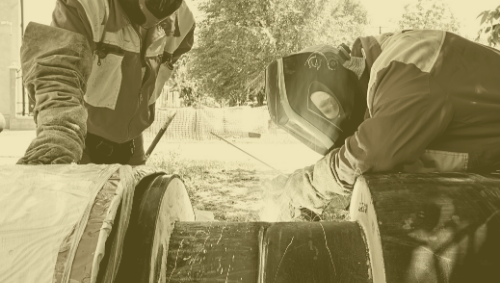Just How Long is Welding School Training Anyway?
The first requirement to become a professional welder is to graduate high school or get a GED. After that, aspiring welders usually begin their training journey at a welding trade school, college, or university. The chosen educational route determines just how long welding school training lasts for the student-welder.
A welding school certificate program usually lasts from 6 to 18 months. An associate’s degree in welding technology takes up to two years to earn. Plan on four years, or more, to complete a bachelor’s degree program in welding engineering.
Excellent research and knowing how much time and money you can devote to your education are essential. It will give you the insight to develop a personalized path to become a welder that leads to career opportunities.
In this article:

Welding School Training Path
- Earn a high school diploma or GED
- Attend a welding training school or degree program taking six months to four years
- On-the-Job Training – Further develop skills that vary by employer and your position.
- With your welding school certificate of completion (not to be confused with welding certification) or diploma in hand you are ready for a welding job. You’ll continue to develop your welding skill and have time to earn the certification required by the employer.
- Welding school graduates may choose to enter a welding apprenticeship program. You learn about the trade while on-the-job. Apprentices get paid a percentage of a journeyman’s wage. Apprenticeships typically last around four years.
- Welder Certification will often be a requirement depending on the state you live in or the company you work for. These tests are nationally standardized by the American Welding Society (AWS). Becoming a AWS certified welder requires passing a written and exam and a hands-on test to determine your abilities. The time to earn your certifications will vary.
In this article, we’ll focus on the different welding school options and how long they take.
Here’s a quick (3-min.) video tour of a welding school:
Training School Options for Welders
The three most common school options to become a professional welder are:
- Welding Certificate Programs provided by trade schools and Vocational-Technical Institutes
- Associate’s degree (A.S.) programs in a Welding Technology program at a trade school or community college
- Bachelor’s degree (B.S.) programs in Welding Engineering from a college or university
Each welding school option varies in cost, and the content learned. Some programs are very basic and prepare you for an entry-level position. While others are very specialized and develop skills that allow you to step into a better-paying position right out of the gate.
Some A.S. degree programs focus on welding with exotic metals, while others concentrate on the auto industry. They’re not all the same, so dig into the curriculum for every school you’re interested in.

How Long are Welding Trade School Programs?
Completion of a welding school program can take from six to eighteen months depending on the curriculum of individual programs.
All programs will offer basic welder classes including the four fundamental processes: gas metal arc welding (GMAW), gas tungsten arc welding (GTAW), flux-cored arc welding (FCAW), and shielded metal arc welding (SMAW). They’ll also cover related subjects like math, computer, and blueprint reading skills.
12 Examples of Trade School Welding Programs
Tulsa Welding School, TX, FL, OK
With three locations in three different states, Tulsa Welding School offers the largest variety of welding programs in the country. Some skills offered are pipe welding, HVAC, electrical, and specialty metals.
Lincoln Electric Welding School
Lincoln’s welding program is known for being one of the most comprehensive in the world. They hold all courses on campus. The school is in Cleveland, Ohio. Lincoln offers a 15-week program.
Arizona Automotive Institute
Offers a 40-week course that provides comprehensive classes to welders. Shielded metal arc, gas tungsten arc, gas metal arc, and flux core arc welding are some skills students learn.
Knight School of Welding
Offers programs that run 4 to 14 weeks long. The school offers programs in five different areas of specialization. The programs are all certified by AWS.
Vincennes University
Offers a 12-month program. This University in Indiana partners with Lincoln Electric through many of its core programs. Therefore, students can expect a relatively standardized curriculum.
Albany Technical College
In Georgia, this school offers both certification programs and A.S. degree programs.
Ashland Community and Technical College
This is actually a 14-month degree program. Graduates qualify to begin work as boiler-makers and pipe-fitters, among other specialties.
Hobart Institute of Welding Technology
This school is relatively affordable compared to other quality programs. The school has over twenty different programs.
Welder Testing and Training Institute
Offers a combination program that is less than $10k. The American Welder Society has accredited WTTI along with four other nationally-recognized organizations.
University of Alaska Anchorage
Even in Alaska, students weld. In fact, UAA has an extensive campus with many facilities dedicated to welders. Ship repair and military equipment are two specialties this program is known for.
Akron Testing Laboratory and Welding School
Ohio has many schools. Akron Testing is one of the biggest outside of Cleveland. Graduates can enter careers with local manufacturing companies, pressure piping companies, and construction contractors.
Apex Technical School
Offers a combination welding technology course. This school also specializes in work with exotic metals. They hold all courses in person. The school has been teaching for over forty years.

How Long Does It Take to Get an A.S. in Welding Technology?
Typically, an A.S. degree in welding technology will take two years to gain. There are a few programs where students can graduate after completing three semesters. Expect these programs to be more intensive.
There is a significant overlap in coursework between training programs and A.S. programs in welding technology. Both certificate students and degree students learn the foundational skills of welding work. For example, GMAW/MIG, GTAW/TIG, SMAW, and FCAW are skills both types of students learn.
A.S. degree students spend significantly more time in the classroom compared with students of certificate programs. Therefore, A.S. degree students graduate with an education that is more well-rounded.
6 Schools to Get a Welding Tech Degree in Two Years or Less
New England Institute of Technology
NEIT offers a degree program that is uniquely modern. Students involve themselves in studies that range from Computer-Aided Design (CAD) to Robotic Control Systems.
Albany Technical College
Albany Tech offers both certificate programs and degree programs. Subjects include blueprint reading and overhead SMAW.
Arizona Automotive Institute
Degree programs here offer courses that emphasize job skills in the automotive industry. In fact, they use vehicles of all kinds for practice in shop classes.
Ferris State University
Ferris State is a well-known university in Michigan that offers both A.S. and B.S. programs. The program labs are the biggest in Michigan.
Hobart Institute of Welding
Also in Ohio, Hobart Institute is one of the most reputable schools in the country. One reason is that welding has remained the school’s sole focus since 1930.
Lincoln Electric Welding School
Offers A.S. programs besides training programs. Lincoln emphasizes student understanding of the corporate structure behind the welding industry. On-the-job training is also central to the school’s programs.

How Long to Get a Welding Engineering Technology Degree?
Typically, a B.S. degree in Welding Engineering will take four years. However, there are some employers that prefer a master’s degree, requiring six years. Welding Engineers can make over $100k a year. A B.S. degree program trains students in analytic software, scientific software programs, CAD, software, and other computer-based skills.
6 Schools Offering Four-Year Degrees in Welding Engineering Technology
LeTourneau University
LeTourneau offers a single Welding Engineering Tech Degree program. Because it is a smaller school, class sizes are also small. This can be a positive feature for students that require more help from teachers.
Waukesha County Technical College
Offers a B.S. degree program. This includes courses covering the four major processes and metal fabrication, blueprint reading, and career-related math courses.
Weber State University
Offers a Bachelor’s degree in Manufacturing Engineering Technology. This B.S.program includes six courses on metallurgy and twenty courses/labs under the Manufacturing prefix.
Cincinnati State Technical College
Offers three Welding Engineering Tech. degree programs. This large school is in a large city in southern Ohio.
North Central Kansas Technical College
With one Welding Engineering Tech degree program, this small college is in a rural environment. Class sizes are relatively low, and the school has an excellent reputation.
Ferris State University
This University offers both A.S. and bachelor’s degrees. Their Welding Engineering Tech degree is well known for its emphasis on high-tech application. Robotics and laser resistance welding are two classes that illustrate this.
Conclusion
Clearly, there is an abundance of options available that enable you to complete welding school in 6 to 18 months or earn a related degree in 2 to 4 years. These paths all lead to employment and/or apprenticeship, AWS certification, and a promising welding career.
The next step is to identify the exact parameters on which you will base your choice of schools. By discerning exactly how much time and money you can devote to your education, you will see a range of possibilities.
By looking forward to your ideal future career as a welder, you can begin tracing your training path back to where you are now.

